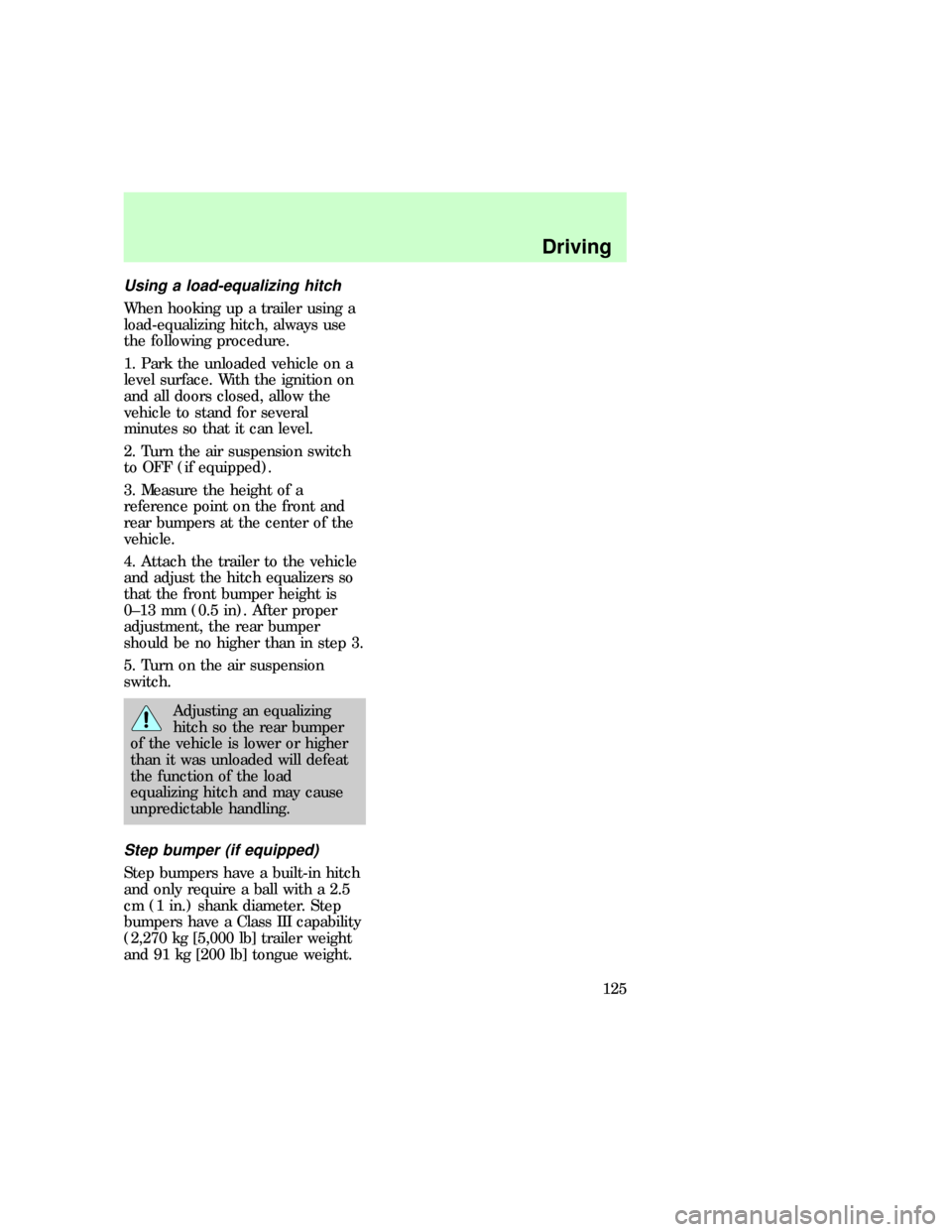Page 22 of 219
Fuel pump shut-off switch
Refer to theRoadside
emergencieschapter for
information on operating the fuel
pump shut-off switch.
f12_air_suspension
Controls and features
23
Page 23 of 219
Air suspension load leveling (if
equipped)
Your vehicle is equipped with an
air suspension system for the rear
suspension that levels your vehicle
when carrying heavy loads. Refer
toAir suspension load leveling
in theDrivingchapter for more
information.
OFF
f12_climate_controls
Controls and features
24
Page 94 of 219
particularly when one or more
wheels are on a surface with poor
traction.
AIR SUSPENSION (IF
EQUIPPED)
The air suspension system for the
rear wheels is designed to keep
your vehicle at a constant level by
adding or releasing air from the
rear springs to compensate for
increases or decreases in vehicle
load.
Normal vehicle operation does not
require any action by the driver.
The air suspension switch is
located behind an access panel
underneath the passenger side
instrument panel.
Press the air suspension switch to
OFF when jacking or hoisting your
vehicle.
On vehicles equipped with
Air Suspension, turn OFF
the Air Suspension switch prior
to jacking, hoisting or towing
your vehicle.
OFF
f12_air_suspension
f12_transmission
Driving
95
Page 122 of 219
Trailer towing table (F-250 4x4 manual transmission)
4.6L 3.73 3,533 (7,800) 1,224
(2,700)5.52 (60)
SuperCab F-250
4.6L 3.31 3,261 (7,200) 952 (2,100) 5.52 (60)
4.6L 3.73 3,533 (7,800) 1,224
(2,700)5.52 (60)
TOWING A TRAILER
Your vehicle may tow a class I, II
or III trailer provided the
maximum trailer weight is less
than or equal to the maximum
trailer weight listed for your engine
and rear axle ratio on the above
charts.
Your vehicle's load capacity is
designated by weight, not by
volume, so you cannot necessarily
use all available space when
loading a vehicle.
Towing a trailer places an
additional load on your vehicle's
engine, transmission, axle, brakes,
tires and suspension. Inspect these
components carefully after any
towing operation.
f12_trailer
Driving
123
Page 124 of 219

Using a load-equalizing hitch
When hooking up a trailer using a
load-equalizing hitch, always use
the following procedure.
1. Park the unloaded vehicle on a
level surface. With the ignition on
and all doors closed, allow the
vehicle to stand for several
minutes so that it can level.
2. Turn the air suspension switch
to OFF (if equipped).
3. Measure the height of a
reference point on the front and
rear bumpers at the center of the
vehicle.
4. Attach the trailer to the vehicle
and adjust the hitch equalizers so
that the front bumper height is
0±13 mm (0.5 in). After proper
adjustment, the rear bumper
should be no higher than in step 3.
5. Turn on the air suspension
switch.
Adjusting an equalizing
hitch so the rear bumper
of the vehicle is lower or higher
than it was unloaded will defeat
the function of the load
equalizing hitch and may cause
unpredictable handling.
Step bumper (if equipped)
Step bumpers have a built-in hitch
and only require a ball with a 2.5
cm (1 in.) shank diameter. Step
bumpers have a Class III capability
(2,270 kg [5,000 lb] trailer weight
and 91 kg [200 lb] tongue weight.
f12_step_bumper
Driving
125
Page 128 of 219
Exceeding these limits may allow
water to enter critical vehicle
components, adversely affecting
driveability, emissions and
reliability.
Servicing when towing
If you tow a trailer for long
distances, your vehicle will require
more frequent service intervals.
Refer to the ªService Guideº for
more information.
SNOWPLOWING
Ford recommends the following
specifications for low speed,
personal use snow removal:
²F-150 4WD long wheelbase or
F-250 4WD Regular Cab
²4.6L or 5.4L engine
²Super engine cooling
²Heavy duty front suspension
package
²Automatic transmission with
auxiliary automatic transmission
fluid cooling
²All-terrain tires
Do not install a snowplow and
plow with your vehicle until it has
been driven at least 800 km (500
miles).
Installing snowplow
Read the following instructions
before installing a snowplow:
²Front GAWR must not exceed
63% of the GVW. Add ballast
weight to the back of the
f12_service_towing
f12_snowplowing
f12_install_plow
Driving
129
Page 136 of 219
Instrument panel fuses
Always replace a fuse with
one that has the specified
amperage rating. Using a fuse
with a higher amperage rating
can cause severe wire damage
and could start a fire.
Position Amps Description
1 15 Stop/turn lamps and turn indicators
2 5 Instrument cluster
3 25 Cigarette lighter
4 5 Power mirrors, autolamp, remote
anti-theft/keyless entry, headlamp relay and
parking lamp relay
5 15 Speed control, daytime running lamps, climate
control blend door, backup lamps, A/C clutch
coil
6 5 Brake-shift interlock, generic electronic module
(GEM)/central timer module (CTM) and air
suspension module
7 - Not used
8 5 Radio, remote anti-theft/keyless entry, GEM
module/CTM module
1
1
2
3
4
512 22
21323
31424
4
16 15
25
526
61727
71828
81929
11 21 31930
10 20
f12_pass_comp_fuses
Roadside emergencies
137
Page 138 of 219
Relays
Position Description
1 Interior lamps relay
2 Battery saver relay
3 Not used
4 One touch down relay
5 Accessory delay relay
Power distribution box
Lift cover towards left of vehicle to
access the power distribution box.
Always disconnect the
battery before servicing
high current fuses.
Always replace the cover
to the Power Distribution
Box before reconnecting the
battery or refilling fluid
reservoirs.
Fuses
Position Amps Description
1 20 Trailer tow back-up and tail lamps
2 10 Air bag diagnostic monitor
3 15 Power locks
4 15 Air suspension
5 20 Horn
6 15 Audio system
29
6
5
4
3
2
1 28
27
26
25
24
2319
18
17
16
15
14
13
22
21
20
12
1197531
12108642
f12_eng_comp_fuses
Roadside emergencies
139